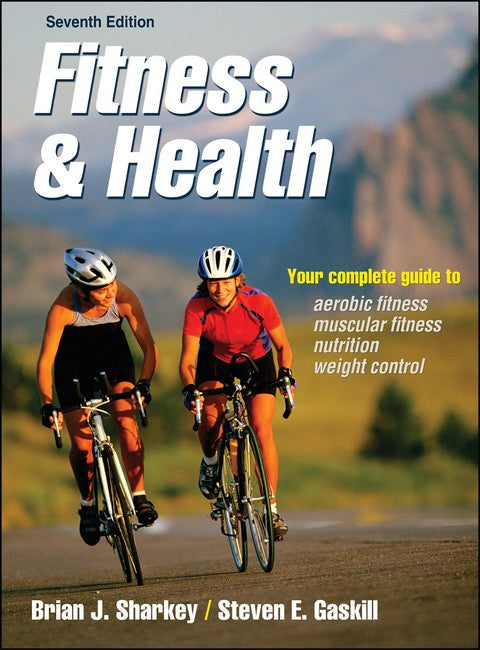Brian J. Sharkey, PhD, has nearly 40 years of experience as a leading fitness researcher, educator, and author. Sharkey served as director of the University of Montana's Human Performance Laboratory for many years and remains associated with the university and lab as professor emeritus. He also served as a consultant with the U.S. Forest Service in the areas of fitness, health, and work capacity. Sharkey is a fellow and past president of the American College of Sports Medicine and has served on the board of trustees. He served on the NCAA committee on competitive safeguards and medical aspects of sports, where he chaired the Sports Science and Safety subcommittee, which uses research and data on injury to improve the safety of intercollegiate athletes. Sharkey also coordinated the U.S. Ski Team Nordic Sportsmedicine Council. In 2009, Sharkey recevied the Fire Safety Award from the International Association of Wildland Firefighters. Sharkey and his wife, Anne, reside in Missoula, Montana. He enjoys hiking, paddling, cycling, and both cross-country and downhill skiing. Steven E. Gaskill, PhD, is a professor in the department of health and human performance at the University of Montana. His research interests include the relationship of physical activity to cognitive functioning in children; submaximal aerobic fitness and its relationship to work capacity and chronic disease; and long-duration work and exercise fitness as related to fitness, fatigue, immune function, and cognitive performance. Gaskill has published over 40 articles in refereed journals, presented his reasearch at numerous conferences, and authored three books. Gaskill worked for the U.S. ski team for 10 years as head coach of the Nordic combined (ski jumping and cross-country skiing) and cross-country teams and as director of the coaches' educational programs. He has coached at three Olympic Games, and 20 skiers who have trained under him have competed in the Olympics. In 1992, the U.S. Ski Association named him the U.S. Cross-Country Coach of the Year. Gaskill enjoys backpacking, tennis, mountain biking, cross-country skiing, fishing, and mountaineering. Serious about the active life, he continues to be active year round with his wife, Kathy Sharkey and Gaskill also coauthored Sport Physiology for Coaches (Human Kinetics, 2006).
Request Academic Copy
Please copy the ISBN for submitting review copy form
Description
Part I. Physical Activity, Fitness, and Health Chapter 1. Health Benefits of Activity and Fitness Activity Reduces the Risk of Coronary Artery Disease Activity Reduces the Risk of Chronic Diseases Activity Increases Longevity Summary Chapter 2. Mental and Cognitive Health: A Sound Mind in a Sound Body Activity Reduces Anxiety and Depression Activity Minimizes Stress Activity Improves Cognitive Health Activity as a Positive Addiction Summary Chapter 3. Activity and Personal Health Assessment: It's Your Responsibility Functions of Health Screening and Early Detection Annual Medical Examination Cholesterol Screening Pre-Exercise Medical Examination Evaluating the Risks of Activity Individual Health Risk Analysis Summary Part II. Turning Your Life Around Chapter 4. Psychology of Activity: Learning to Play Motivation Adherence Goal Setting Setting Your Preference to Exertion Summary Chapter 5. Behavior Change: Gaining Control Activity in Modern Society Barriers to Physical Activity Environment and Behavior Stages of Behavioral Change Behavior Modification Strategies Positive Behavior Maintenance Relapse Solutions Visualization Strategies Summary Chapter 6. Meaningful Activity: Lifetime Vitality Meaningful Physical Activity Incorporating Purposeful Activity into Daily Living Environment and Purposeful Activity Aging and Activity Health Habits for Longevity Personality Attributes for Longevity Age and Performance Summary Part III. Understanding Fitness Chapter 7. Physiology of Fitness: Muscles, Energy, and Oxygen Muscle Contractions Energy Sources Energy for Contractions Supply and Support Systems Genetic Responses to Exercise Summary Chapter 8. Aerobic Fitness: Stamina and Efficiency Aerobic Exercise Aerobic Fitness Aerobic Training Effects Aerobic Training and Muscle Function Aerobic Training and Body Composition Aerobic Training and the Skeletal System Training Supply and Support Specificity of Training Aerobic Fitness Field Tests Summary Chapter 9. Muscular Fitness: Strength and Endurance Muscular Strength Muscular Endurance Flexibility Speed Power Agility and Skill Balance Benefits of Muscular Fitness Strength Training Effects Endurance Training Effects Methods of Training Muscle Soreness Force-Velocity Relationship Preload and Elastic Recoil Core Training Muscular Fitness Field Tests Summary Part IV. Improving Fitness Chapter 10. Aerobic Fitness Training: Steps for Success Fitness Prescription Training Tips Aerobic Fitness Options Exercise Risks Sample Aerobic Fitness Prescriptions Summary Chapter 11. Muscular Fitness Training: Lifetime Mobility Muscular Strength Fitness Prescription Muscular Endurance Fitness Prescription Sample Muscular Fitness Prescriptions Summary Part V. Activity and Weight Control Chapter 12. Energy and Nutrition: Fuel for the Active Life Nutrients Dietary Guidelines Energy Intake Energy Expenditure Calculating Caloric Intake Estimating Caloric Expenditure Diet and Performance Summary Chapter 13. Weight Control: More Than Calories Count Overweight and Obesity Measuring Body Fat Ideal Body Weight Activity and Weight Control Exercise Prescription for Weight Control Adopting a Healthy Diet Weight-Control Fallacies Sensible Weight Gain Summary Part VI. Performance Chapter 14. Training: Athletic Performance Training Principles Training Fallacies Designing Your Training Program Periodizing Your Training Program Psychology of Performance Overtraining Cross-Training Fitness and Work Summary Chapter 15. Environment: Acclimate, Then Perform Regulating Temperature Exercising in the Heat Exercising in the Cold Exercising at Altitude Avoiding the Effects of Air Pollution Summary

